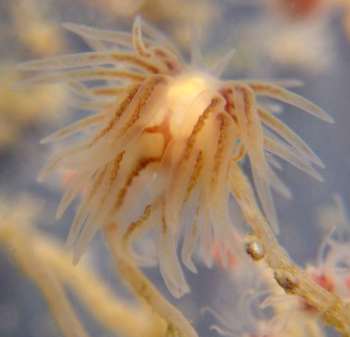
Cumanotus cuenoti
Pruvot-Fol, 1948
Order: NUDIBRANCHIA
Suborder: AEOLIDINA
Family: Cumanotidae
DISTRIBUTION
Known on ly from Arcachon, SE [Atlantic] coast of France.
PHOTO
'Hortense', Cap Ferret, Arcachon Basin, France, Atlantic coast . February 2005. Size : 6-9 mm .Depth : 5-6 m. on their food Ectopleura dumortieri. Photographer: Marina Poddubetskaia
Very similar to Cumanotus beaumonti. this species is apparently smaller, not exceeding 10 mm in length, and lacks oral and propodial tentacles. It also has fewer denticles on the radular teeth. Cumanotus cuenoti feeds on Tubularia, and Ectopleura dumortieri (see Tardy & Gantes, 1980). It swims by vigorous wriggling of the body and cerata.
At present this species is known only from Arcachon, on the SE Atlantic coast of France. The larger C. beaumonti has previously only been reported from the British Isles and Norway, where it is considered to be very rare, and is reported in the Forum from the Mediterranean. Some authors have considered C. cuenoti to be a synonym of C. beaumonti, their differences perhaps being related to size.
-
Pruvot-Fol,A (1948): Deux aeolidiens d'Arcachon. Journal de Conchyliologie 88(3), 97-100
-
Tardy J. & Gantes H. 1980. Un Mollusque Nudibranche peu connu : Cumanotus cuenoti A. Pruvot-Fol, (1948) ; redescription, biologie. Bulletin de la Société zoologique de France, 105: 199-207.
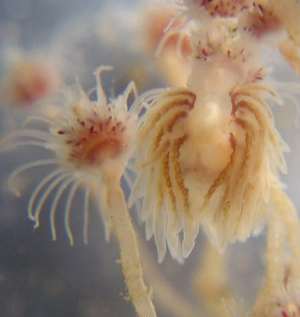
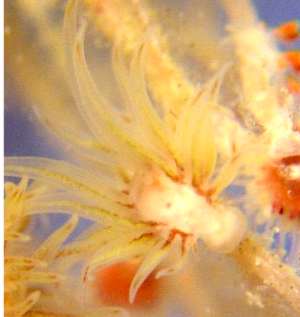
Rudman, W.B., 2005 (April 12) Cumanotus cuenoti Pruvot-Fol, 1948. [In] Sea Slug Forum. Australian Museum, Sydney. Available from http://www.seaslugforum.net/find/cumacuen
Related messages
Re: Cumanotus beaumonti and C. cuenoti
May 13, 2006
From: Marina Ossokine
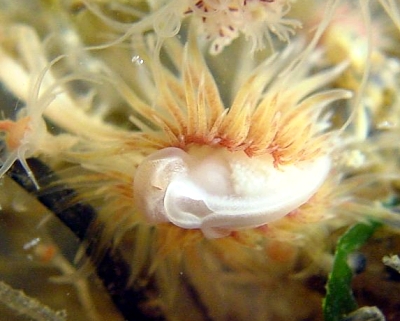
Concerning message #16575:
Dear Bill,
I will try to answer your questions on Cumanotus cuenoti.
The food: I'm bad with hydroids, bryozoans, sponges and anemones identification. The food of this Cumanotus was identified as Ectopleura dumortieri by Gantes, that's why I used this name. But I agree it could be Tubularia indivisa as well. All I can do is to send you a better photo of it (see attached here).
The size and oral tentacles: I saw Cumanotus cuenoti in February and May in 2004, and in February-March in 2005. They are present in Arcachon Basin as long as their food is here. During these periods I saw dozens of specimens of this species and the largest ones were about 10 mm, no larger. I have never seen any specimen with oral tentacles. Please, see attached here photo which shows the head and foot morphology quite well : no oral tentacles nor foot corners visible here. I'm convinced all these animals were mature at this size because numerous egg-ribbons were covering the related food. And even the eggs shape is a little different from the photo in Cristian Magnani's message [#16466 ]: it is very consistent, corkscrew-shaped with close whorls, like in the attached photo.
So, to my opinion, Cumanotus cuenoti is distinct from C. beaumonti.
Distribution: Cumanotus cuenoti has also been seen in Gironde estuary, northern to Arcachon Basin.
Locality: 'Hortense', Cap Ferret, Arcachon Basin, 4-5m, France, Atlantic Ocean, February 23, 2006. Length: animal : 10 mm / eggs : 8 mm. Photographer: Marina Poddubetskaia Ossokine.
I hope this will help.
Best wishes,
Marina.
Nembro website
nembro@nembro.info
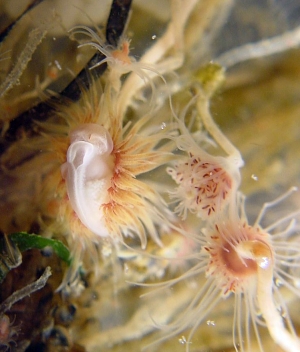
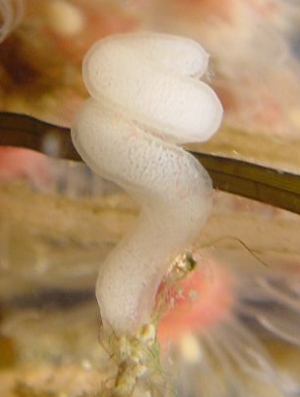
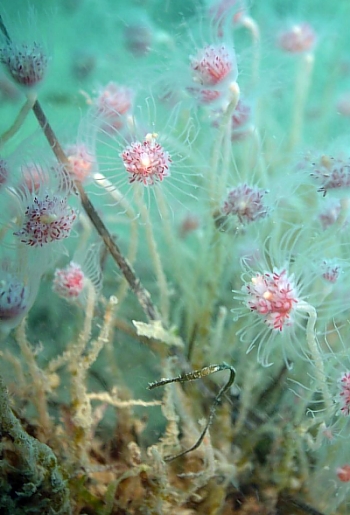
Dear Marina,
Thanks very much for all this extra information. I thought we would have to wait until your next visit to Arcachon. I am not a great hydroid expert either, but my understanding is that Ectopleura dumortieri is a solitary hydroid while yours is clearly a colonial form. I think it could well be Tubularia indivisa.
I also agree that there are no signs of oral tentacles or tentacular foot corners. Concerning size, many species start breeding before they reach full size, but I agree in this case, with so much food available, it would be strange if they had not grown to a larger size if they were capable of it. Apart from checking again, next time your in Arcachon, whether they stop growing before all the hydroid polyps are eaten, there is not much we can do without looking at some anatomy. One thing still left to check is whether Cristian can find small specimens of his species and see if they have tentacles.
Your messages and Cristian's have certainly given us a lot of new information on these rare species.
Best wishes,
Bill Rudman
Re: Cumanotus from Slovenia
April 12, 2005
From: Marina Poddubetskaia
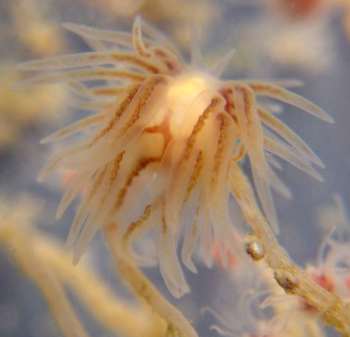
Dear Bill,
Concerning the 'Cumanotus from Slovenia' message [#13477]: I don't think Cumanotus cuenoti is a synonym of Cumanotus beaumonti but a full, very distinctive species with the characteristic brown pattern on the posterior part of the body. For 9 months now I live in Bordeaux and I dive regularly in Arcachon Basin. It is a wonderful place for opisthobranchs. This winter, the presence of Cumanotus cuenoti was very brief : I saw them for less than one month, in February. Maybe it's why they are considered as rare.
Locality: : 'Hortense', Cap Ferret, Arcachon Basin, France, Atlantic coast . February 2005. Size : 6-9 mm .Depth : 5-6 m. on their food Ectopleura dumortieri. Photographer: Marina Poddubetskaia
Please, have a look at my page about it for more photos:
http://www.nembro.info/uk_cumanotus_cuenoti.html
Best wishes,
Marina.
nembro@nembro.info
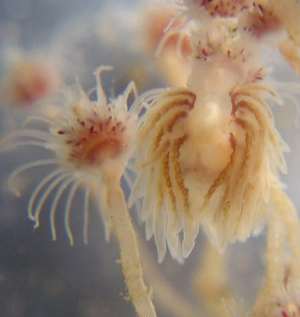
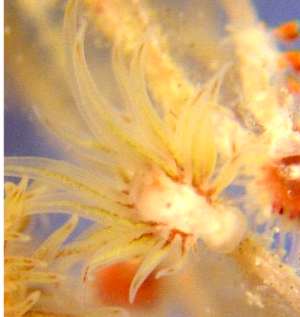
Dear Marina,
Thanks for this valuable information Marina. All I knew about this species was Pruvot-Fol's original description (1948), based on a single animal, and Tardy and Gantes' (1980) paper redescribing it and reporting on some aspects of its biology. In fact their line drawings of an animal on the hydroid Ectopleura look very like some of your photos. At present Arcachon is the only place this species has been reported.
The brown markings you say are very distinctive are in fact the ducts of the digestive gland which can be seen through the almost transparent body wall. Certainly it seems to differ externally in the much smaller rhinophores and lack of oral tentacles. Internally the radular teeth have fewer denticles than C. beaumonti.
What we need to know is whether these differences are age related. I realise the small C. cuenoti lay egg ribbons and so are mature, but many nudibranchs begin egg laying while still very small. It is certainly an interesting puzzle and certainly worth keeping in mind next time any one finds these animals again.
Best wishes,
Bill Rudman
